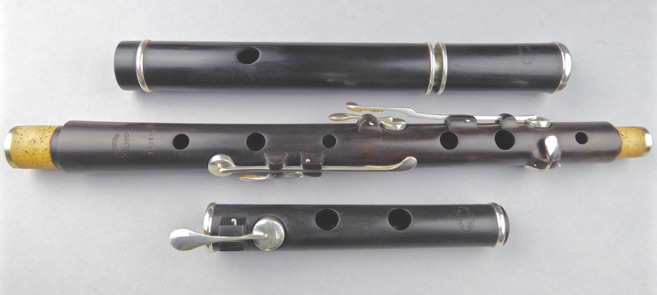Keyed Flutes

We can offer keyed flutes in two styles:- the traditional block mounted flute, or post mounted instruments.
Block mounted flutes have the keys mounted between blocks which are an integral part of the wooden flute body. Post mounted flutes have small silver posts which are screwed into the wooden flute body, and the key axle runs between these.
Many people are confused about the difference these two styles of mounting might make to the flute and it's playability. There is also some doubt about the authenticity of the post mounts as opposed to the block mounts on a traditional flute. Curiously, keys mounted on metal "posts" attached to the wooden body of an instrument pre-date the block mounted method by several hundred years! However by the time ( late 17th century) that keys to provide the semitones of the scale began to be added to woodwinds such as oboes and flutes, all makers used the block mounted system. This became the standard method of mounting keys until the early nineteenth century, when post mounting as we know it today, began to be used on some flutes. When normal single action keys, such as the long C or the G#, are in question there is really no difference between block or post mounts...given that both are well made.
One factor that puts some players off the post mounted system are the "German Flutes"...mass produced factory instruments which in many cases were poorly made...resulting in an association between post mounts and poor quality. Those who have only seen post mounts on such instruments should remember that some of the finest English and continental simple system flutes of the mid to late nineteenth century were also post mounted.
Which style you choose is largely a matter of personal preference, both styles are equally mechanically efficient. With the lower foot joint keys.....the C# and C, somewhat more skill is required to use the block mounted keys, and careful maintenance is required to keep them in top order. Post mounted foot joints...in the same style as one would see on the foot of a standard Böehm orchestral flute, are more mechanically efficient due to the much shorter arms that the keys operate on, and make the playing of the low C# and C easier.
For this reason we recommend post mounted keys for eight keyed flutes, or for those buying a four or six keyed flute with the intention of later upgrading to eight keys.
Traditional players don’t always conform to the standard, “classical” way of holding a flute, and quite a few players use what’s called the flat fingered or piper’s grip. I make a special key set up for those who play in this way, which basically moves the long C and F out of the way of the fingers, makes the G# accessible by making it a cross key, and gives the Bb to the right forefinger. You can see a block mounted flute set up like this here. Before you decide about keys have a look here to see if you need to have a flute made to suit your grip, and also to see pics of the block mounted style.
Keys are solid sterling silver, as are the axle pins of block mounted instruments, and as standard I use stainless steel coil springs which are hidden between the blocks. Traditional brass or bronze leaf springs are available on request.
The number of keys is the choice of the player, and we can make flutes with any combination of keys, however I insist on a minimum of three...those for C natural, F natural, and G#.
If you buy a 3 keyed flute, it can be upgraded easily as to the number of keys. The blocks for the Bb, and the long or short F natural are already present. A new foot can be provided carrying the Eb key.
The Six-Keyed Flute
The six-keyed flute is, we find, the most popular, with keys giving C natural, G sharp, B flat, E flat, and two keys for F natural (the long and short Fs) thus making the instrument fully chromatic. The second F natural key ( the long F) allows the player to go directly from D to F natural, a move which occurs fairly often in traditional music, and which is impossible with only the short F.
I think it is becoming more widely accepted that in Irish traditional flute playing, a six-keyed flute is regarded as a fully keyed flute.
Keyed flutes of course sound the same as keyless, apart from the extra notes available.
Again, if you go to YouTube and look for Orlaith McAuliffe, she plays as great set on one of my six-keyed flutes. It's the first one that comes up....
The Eight-Keyed Flute
The majority of old wooden cone bore flutes that one comes across have eight keys. These would have been the six mentioned above, and two keys on the foot joint which extend the range of the flute down through C# to C, a full tone below the normal bottom D.
We make flutes with these keys, but would ask that you contact us to discuss ordering an eight keyed flute, as there is a degree of confusion and discussion among players as to just how useful these extra keys are, for Irish music in particular.
This key work is expensive, and we want to ensure that customers fully understand the potential that the foot joint keys will give them.
